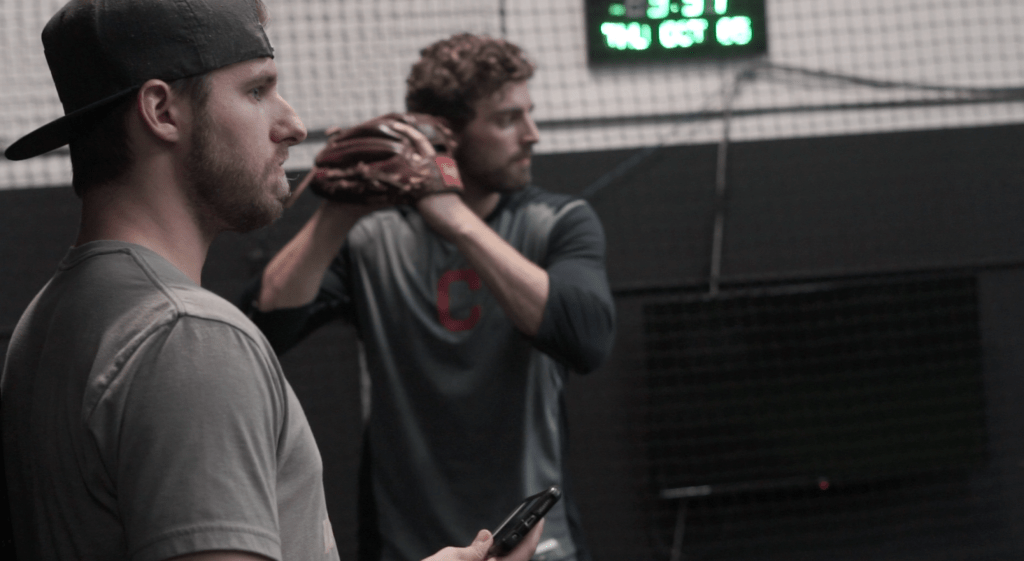Fastballs vs. Offspeed Pitches – Comparative and Relative Elbow Stress

Offspeed/breaking pitches such as the curveball and slider have received so much attention and scorn in the last few years that they are part of the reason for an increase in arm injuries. In this article, we will attempt to examine this claim with relevant research and data that we’ve collected in our gym during the pro offseason.
A number of studies have examined the relationship between curveballs and fastballs as well as the relationship each have to stress while only a few studies have looked at the stress of sliders and changeups.
Let’s briefly break down many of the studies in order to provide our own analysis of the data that we have collected.
What the Peer-Reviewed Research Says
Do MLB pitchers who throw more offspeed pitches have Tommy John surgery more often?
Major League Baseball Pitch Velocity and Pitch Type Associated with Risk of Ulnar Collateral Ligament Injury looked into that question and didn’t find a relationship.
The researchers examined 83 pitchers who underwent UCL reconstruction and found those who threw a higher percentage of fastballs were more likely to require Tommy John surgery. But there was no statistical difference between pitch type or velocity.
However, Pitch Characteristics Before Ulnar Collateral Ligament Reconstruction in Major League Pitchers Compared With Age-Matched Controls reports that:
“In the season before surgery, MLB pitchers who underwent UCLR demonstrated greater fastball, slider, curveball, changeup, and split-fingered fastball velocities, with no significant difference in pitch type.”
This suggests that pitchers who throw harder are more at risk for injury, and the type of pitches they throw isn’t a factor, contradicting the study above.
In this next study, Kinetic comparison among the fastball, curveball, change-up, and slider in Collegiate Baseball Pitchers observed that there were kinematic differences but few kinetic differences.
This study concluded that that neither the fastball nor curveball was more stressful or potentially dangerous for a collegiate pitcher. The change-up had the lowest kinetics.
Based on this research, essentially there are slight differences in movement between pitches but little difference in the torque or stress numbers.
Is there a difference for youth pitchers?
A Biomechanical Comparison of the Fastball and Curveball in Adolescent Baseball Pitchers examined this question to find that the moments on the shoulder and elbow were less when throwing a curveball than when throwing a fastball.
Effect of Pitch Type, Pitch Count, and Pitching Mechanics on Risk of Elbow and Shoulder Pain in Youth Baseball Pitchers made additional observations.
Using pre and post season phone call interviews the researchers found:
“Overall, almost 15% of all pitching appearances resulted in elbow or shoulder pain, with half (50%) of all subjects reporting elbow or shoulder pain during the season.”
“Overall, only the slider was found to have a significant relationship to elbow pain, and this relationship was especially strong among 13- to 14-year-old pitchers (an odd ratio of 3.49). There was an overall 86% increased risk of elbow pain among slider users. Use of the curveball accounted for a 52% increased risk of shoulder pain, without variation by age group.”
This paper also makes the important distinction that “muscle soreness is normal and necessary in the development of a pitcher, joint pain is not.”
Are there any literature reviews of curveballs in baseball and their relation to injury?
The Curveball as a Risk Factor for Injury: A Systematic Review is a a great review looking at ten biomechanical and six epidemiologic studies on curveballs.
Three of the five epidemiologic studies did not find a significant association between throwing curveballs and elbow or shoulder pain.
Consistent kinematic differences were increased horizontal adduction of the shoulder, increased forearm supination, and decreased wrist extension.
Kinetics (stress numbers) were not increased at the shoulder or elbow:
“Despite much debate in the baseball community about the curveballs safety in youth pitchers, limited biomechanical and most epidemiologic data do not indicate an increased risk of injury when compared with the fastball.”
So we are stuck with a mix of results.
The biomechanical studies have consistently found that curveballs are not only less stressful, but also some surveys have suggested curveballs and sliders cause an increase in pain. There is obviously less data on sliders, and changeups seem to be relatively forgotten.
What We Found
We used the Motus mTHROW Sleeve (validation comparison to a biomechanical laboratory in this PDF) to examine the differences between fastballs and changeups, curveballs and sliders. We compared four fastballs to four offspeed pitches. Pitches were sorted by velocity, and the four fastest of each pitch type was taken in for analysis.
Now, keep in mind for the following graphs that the axes do change to give a better representation of the data that is presented.
As always the data is public and you can find all of it here.
As you can see the fastball was the fastest pitch, and it was also the most stressful pitch when compared to curveballs, sliders, and changeups.
In other words, we found that every offspeed pitch we looked at resulted in less stress than a fastball.
This is consistent with the biomechanical research that is available: fastballs result in higher torques on the elbow.
But let’s look at the data in a different way. Because the velocities were quite different, let’s see what happens when we normalize the stress for velocity.
We’ll take the stress from each group, divide it by the velocity, and then multiply it by 100 to get a whole number. We can call these new units mStress.
Interestingly enough, when the data is normalized, all the relationships flip. We see that every offspeed pitch is more stressful than a fastball when the stress is normalized per velocity. Z-test and T-test results can be found in the data set here. Those tests are able to tell us that there is a relationship worth investigating further.
We also can look closer into the variance, between the fastballs and offspeed pitches, and we do see some differences there as well.
Now this relationship can always change with a bigger sample, but it’s a very interesting finding none the less.
So, could this possibly mean that pitches such as curveballs cause less total torque than fastballs but are proportionally more stressful when you control for velocity?
We can look back at the data in Kinetic comparison among the fastball, curveball, change-up, and slider in Collegiate Baseball Pitchers to see if the normalized relationship is replicated.
After normalized the stress per velocity, the relationship we found in gym holds. Curveballs have the highest mStress followed by sliders. The mStress of the Changeup is comparable to a fastball.
So where does that lead us?
For one, maybe looking just at total stress numbers isn’t enough. Maybe understanding how stress is distributed amongst the muscles of the forearm would lead to a better understanding.
Curveballs are often held in forearm supination for longer than fastballs. Could that change affect the muscles of the forearm in a significant way?
It’s very possible that how the stress is distributed within the elbow as the throw is occurring causes issues.
We also may not be entirely sure how the stress changes as the velocity increases. Pitchers throwing the same velocity may not have the same amount of stress on their elbows. More importantly, we also don’t know how stress increases as one pitcher throws 75 MPH vs 90 MPH.
When a pitcher is warming up, what is the stress on his arm when he is throwing at 65 MPH? At 80 MPH? 90 MPH?
Maybe knowing how that relationship changes will give us a better idea of how offspeed pitches are different than fastballs.
Ultimately, these results won’t end up changing much when discussing different pitches with pitchers at Driveline. However, what it does do is gives us a sample that we can grow to see if these relationships change over time.
Youth Athletes
We still believe that youth athletes (under the age of 14) shouldn’t throw curveballs or sliders.
We’ve covered this area twice before (here & here), but it often comes down to poor arm fitness and neuromuscular control. Youth athletes aren’t conditioned for high workloads, and, fatigued or not, they don’t have the same body control that an adult has.

We may also be ignoring other variables that come into play:
- Are we teaching curveballs/sliders to pitchers who already throw too many innings?
- Are we teaching curveballs/sliders to the pitchers who throw harder than their peers?
- Are we labeling to many young athletes as pitchers only (POs) at too young of an age?
- What percentage of pitches thrown are curveballs/sliders?
At Driveline, we fully believe that youth athletes should focus on developing good movement patterns, intent, and fastball command before trying to learn an offspeed pitch. Fastball command plays well at all ages, and training it at young age is very beneficial.
This article was written by Assistant Researcher Michael O’Connell. Statistical Analysis was completed by Assistant Engineer/Researcher Joe Marsh. Lightly edited by Kyle Boddy, Director of Research and Development.
We’ve published other articles summarizing our research, check them out here!
Comment section
Add a Comment
You must be logged in to post a comment.
Bullpens, Tracking Elbow Torque, and mStress - Driveline Baseball -
[…] As we’ve covered previously, this will also be very important when discussing offspeed pitches as …. Much of the peer-reviewed research has suggested that pitches, such as curveballs, are lower stress than fastballs. We’ve also found this to be the case in our own research. […]
Lon Fullmer -
Maybe, just maybe all the kinisioanotomical work that explain the difference between the violent end of range of motion bone crash that you forearm/elbow joints experience when supination your drive will give you answers with merit. This action weighed against its opposite (pronation) is avoided by all who study stress in this region and will actually give you real answers. Studying the supination just gives you old data.
Reviewing Offspeed Pitches and Elbow Torque - Driveline Baseball -
[…] we looked at offspeed pitches and were able to come close to replicating peer-reviewed research with the Motus sensor. […]
Reviewing ASMI's Biomechanical Analysis of Dr. Marshall's Pitchers (Focus: Performance/Velocity) - Driveline Baseball -
[…] what you hear from coaches.). You can read further reviews on the differences in offspeed pitches here and […]